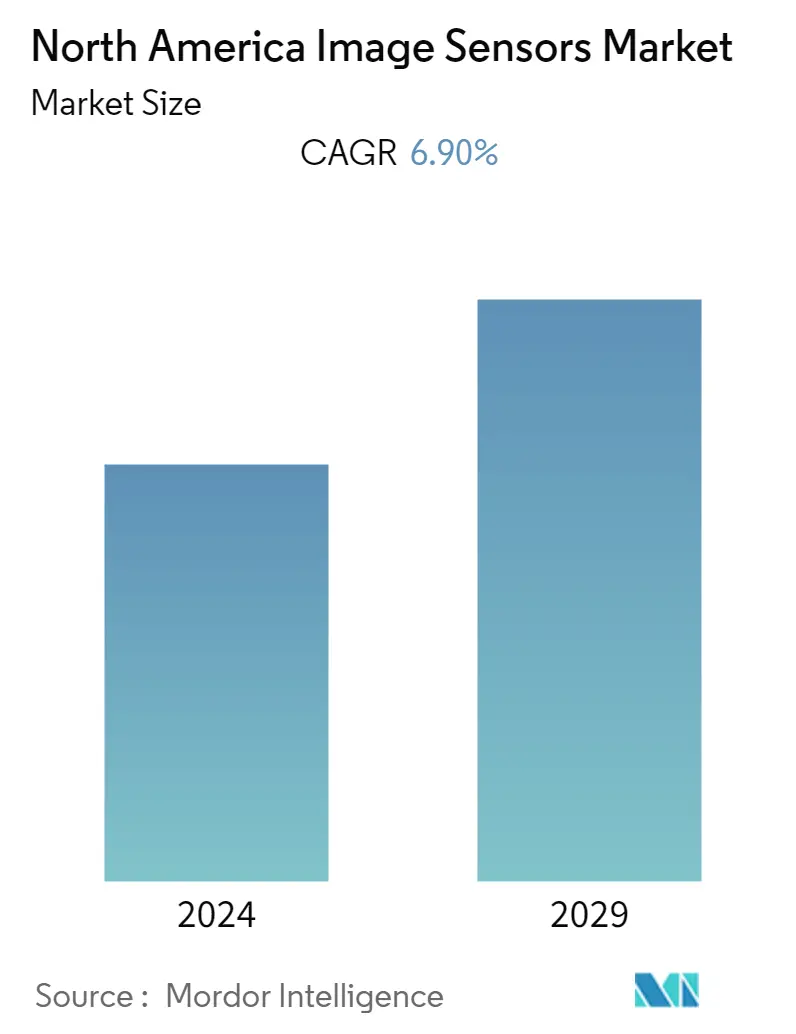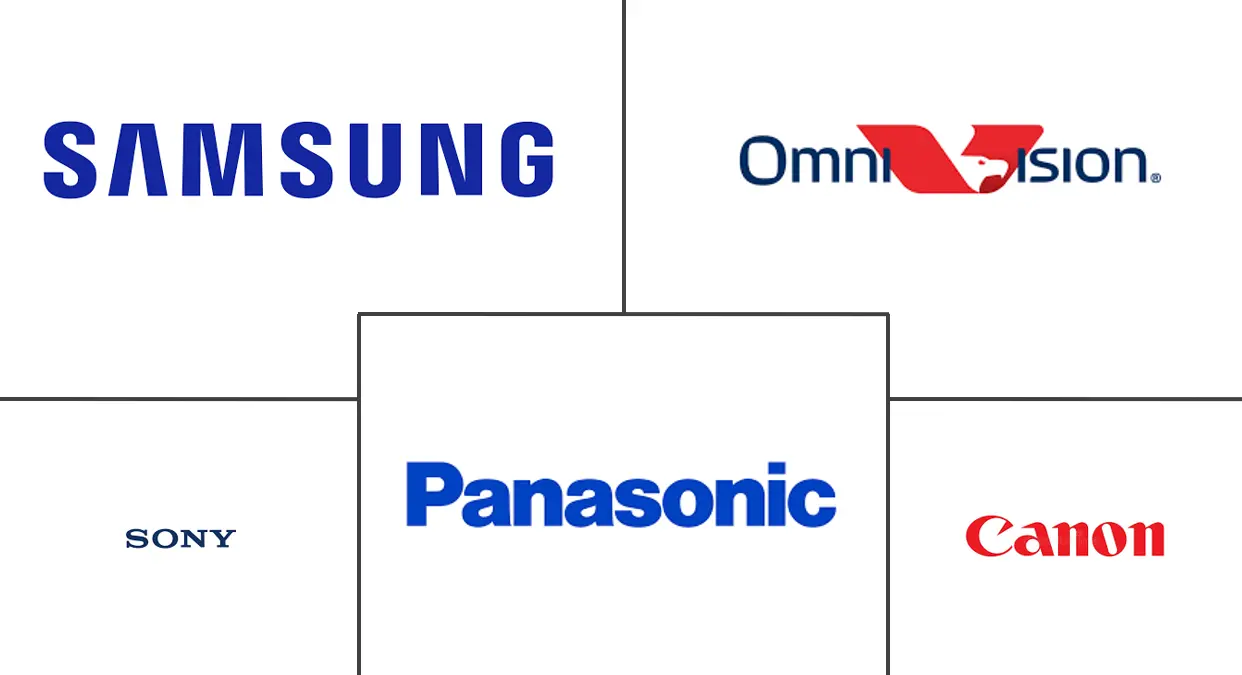Market Size of North America Image Sensors Industry

| Study Period | 2019 - 2029 |
| Base Year For Estimation | 2023 |
| Forecast Data Period | 2024 - 2029 |
| Historical Data Period | 2019 - 2022 |
| CAGR | 6.90 % |
| Market Concentration | Low |
Major Players
*Disclaimer: Major Players sorted in no particular order |
North America Image Sensors Market Analysis
The North American Image Sensors Market is expected to witness growth at a CAGR of 6.9% over the forecast period. The COVID-19 pandemic had a significant impact on the market during the initial period. The supply chain has experienced a massive disruption due to restrictions in the movement of goods and personnel.
- Due to the growing demand for smartphones, security cameras, high-definition cameras, and camcorders, the image sensors market is expected to record a high growth rate during the forecast period. Manufacturers in the region have been striving to improve major parameters, such as resolution, performance, and pixel size.
- IC technology advancements have allowed the incorporation of previously independent functions by integrating sensors in the same chip. For example, a standard mobile phone has independent features, such as a camera, wireless connectivity, and music-playback capabilities. Now, all these functionalities are made available in a single device and have resulted in popularity, thus increasing the production volumes for image sensors, such as CMOS and CCD.
- In terms of consumer electronics, the smartphone has become the primary camera device, dominating still-cameras and DSLRs. Heavy competition in the smartphone segment has driven manufacturers to provide better cameras to have the edge over the competition, which has resulted in high investments in camera technology innovations in this field.
- Further, manufacturing firms in the region realize the benefits of machine vision systems, particularly in areas where redundant tasks, such as inspection, should be performed precisely. Industry 4.0 fueled the development of technologies, like robots playing a crucial role in industrial automation, with many core operations in industries managed by robots. Machine vision supports new applications, like vision-guided robotics, etc.
- Moreover, drones are widely used in North America to conduct surveys, and manufacturers are constantly looking for cameras that can capture images from altitudes. Cameras with higher megapixel resolution and small sensor sizes can be subject to image diffraction effects. Therefore, such disadvantages provide opportunities for the image sensor vendors in the market to introduce larger sensors that showcase better light-gathering ability at the same resolutions.
North America Image Sensors Industry Segmentation
The study tracks the end-user industries, such as consumer electronics, healthcare, industrial, security and surveillance, automotive and transportation, and aerospace and defense, which need image sensing devices, owing to the massive demand for these devices in their businesses. The competitive landscape has been taken to calculate the image sensor penetration and how players involve themselves in organic and inorganic growth strategies. Further, the study analyzes the impact of COVID-19 on the market players and its stakeholders across the supply chain. The same has been considered for arriving at the current market estimation and for future projections.
| Type | |
| CMOS | |
| CCD |
| End-User Industry | |
| Consumer Electronics | |
| Healthcare | |
| Industrial | |
| Security and Surveillance | |
| Automotive and Transportation | |
| Aerospace and Defense | |
| Other End-user Industries |
| Country | |
| United States | |
| Canada |
North America Image Sensors Market Size Summary
The North American image sensors market is poised for significant growth, driven by the increasing demand for smartphones, security cameras, and high-definition imaging devices. The market's expansion is supported by advancements in integrated circuit technology, which have enabled the integration of multiple functions into single chips, enhancing the capabilities of devices like smartphones. This trend has led to a surge in production volumes for image sensors, particularly CMOS and CCD types. The consumer electronics sector, especially smartphones, has become the dominant force in the market, with manufacturers investing heavily in camera technology to maintain a competitive edge. Additionally, the adoption of machine vision systems in industrial automation and the use of drones for aerial surveys are creating new opportunities for image sensor vendors, further fueling market growth.
The market landscape is characterized by intense competition, with key players such as Canon Inc., Samsung, and Sony leading the charge. The introduction of advanced products, like SmartSens' ultra-high-resolution image sensors and ON Semiconductor's high-resolution CCD sensors, underscores the ongoing innovation in the sector. The growing consumer electronics market, coupled with advancements in automotive applications and security systems, is expected to drive the demand for image sensors. The fragmented nature of the market presents significant investment opportunities, attracting new entrants and fostering a dynamic competitive environment. As the region continues to experience robust sales growth in consumer electronics, the demand for high-quality image-capturing capabilities is anticipated to rise, further propelling the market forward.
North America Image Sensors Market Size - Table of Contents
-
1. MARKET INSIGHTS
-
1.1 Market Overview
-
1.2 Industry Attractiveness - Porter's Five Forces Analysis
-
1.2.1 Bargaining Power of Buyers
-
1.2.2 Bargaining Power of Suppliers
-
1.2.3 Threat of New Entrants
-
1.2.4 Threat of Substitute Products
-
1.2.5 Intensity of Competitive Rivalry
-
-
1.3 Industry Value Chain Analysis
-
1.4 Assessment of the Impact of COVID -19 on the Market
-
-
2. MARKET SEGMENTATION
-
2.1 Type
-
2.1.1 CMOS
-
2.1.2 CCD
-
-
2.2 End-User Industry
-
2.2.1 Consumer Electronics
-
2.2.2 Healthcare
-
2.2.3 Industrial
-
2.2.4 Security and Surveillance
-
2.2.5 Automotive and Transportation
-
2.2.6 Aerospace and Defense
-
2.2.7 Other End-user Industries
-
-
2.3 Country
-
2.3.1 United States
-
2.3.2 Canada
-
-
North America Image Sensors Market Size FAQs
What is the current North America Image Sensors Market size?
The North America Image Sensors Market is projected to register a CAGR of 6.90% during the forecast period (2024-2029)
Who are the key players in North America Image Sensors Market?
Canon Inc., Omnivision Technologies Inc., Panasonic Corporation, Samsung Electronics Co. Ltd and Sony Corporation are the major companies operating in the North America Image Sensors Market.

